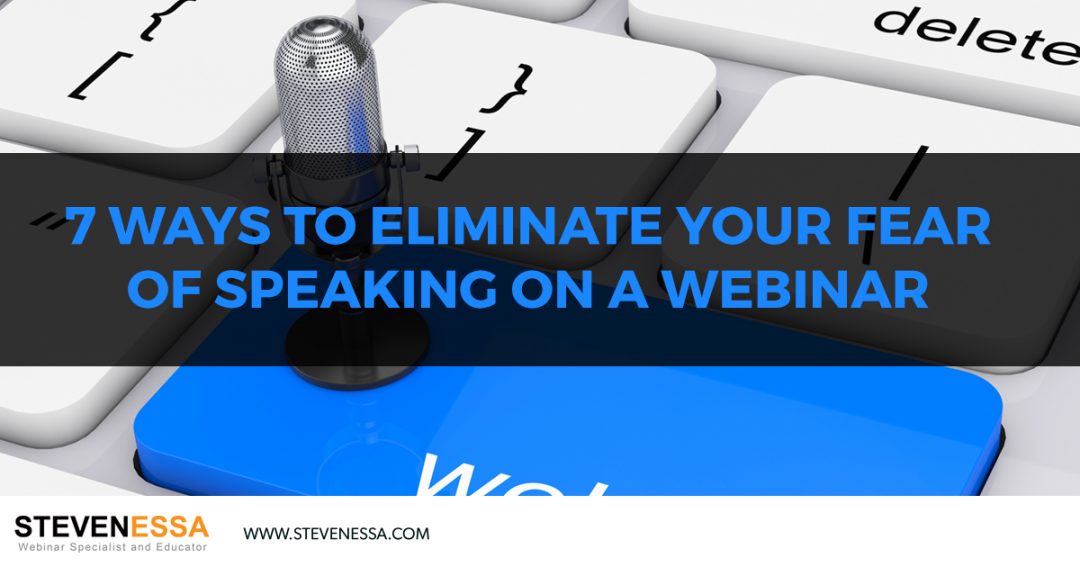Fear of speaking publicly is one of the most common fears. In fact, people are more afraid of public speaking than death itself! Even the most competent and confident people face that fear more often than not. This is why, most people pre-record their webinars as the thought of delivering it live is daunting. But, live webinars convert so much better than replay webinars so by not working on your fear of public speaking, you are leaving a lot of money on the table.
The good news is, public speaking fear, also known as “Glossophobia” can be easily eliminated by following the 7 methods outlined below.
1. Understand your source of fear
To work on your fear of speaking, the first step is understanding where that fear comes from in the first place. The most common reasons why anyone would experience Glossophobia are:
- Self-consciousness: Being listened to by more than one or two people feels intimidating
- Not wanting to appear nervous
- Being judged: Not wanting people to draw conclusions about you
- Being unprepared: Being unable to face the unexpected such as technology failure or questions from the audience
- Previous experience: A bad memory of when you last spoke in front of people and it didn’t go as well as you wanted it to
- Being shy and reserved: A lot of people are by nature introverts, shy and reserved, and therefore, speaking in front of a large group of people is outside their comfort zone.
Having an understanding of your source of fear will enable you to face it head on and in time, eliminate it completely.
2. Be prepared
One of the most effective ways to overcome your fear of public speaking is being prepared for the expected and unexpected. Make sure you rehearse the answers to some common questions people may ask you during the webinar, and make sure you know your topic very well. Avoid mentioning in your webinar anything you are not able to talk about in further detail. Your confidence on a webinar is usually in direct proportion to how well you are prepared and know your subject.
For example, if you include a demonstration on your webinar, make sure you have rehearsed it, so nothing pops up unexpectedly and completely flusters you.
3. Watch other webinars
The more you watch other people’s webinars, the more familiar you’ll become with how they operate and sound like, and therefore will increase your confidence when it’s time to present yours. The more you listen to other people’s webinars the easier it will be for you to model the successful ones, and the easier it will be for you to avoid making their mistakes. This method is also known as “psychological modelling” and it’s simply the process of copying or mirroring someone else’s behaviour. Simply imitate the way they talk, their pace and anything else you like when it comes to the style with which they deliver their presentation.
4. Practice out loud
Practicing several times your presentation out loud, as if you were delivering it live, is the best way to rehearse and get prepared for a flawless presentation. The more you practice out loud, the more confident you’ll feel when the day comes to present it live, as the whole process will feel very familiar to you.
Although it may feel awkward speaking out loud in front of no one, you can record your practice runs and turn the best version into a replay. That way, you not only work towards eliminating your fear of public speaking, you’re also automating your webinar.
5. Master the start and end
Usually, the most intimidating part of a live presentation is the start and the end. This is why, always know word-for-word the first statement you’ll make as soon as you get started, and know word-for-word how you’re going to end your webinar.
Your opening sentence sets the tone of your webinar, and your webinar needs to start powerfully. A sentence such as: “Hello, Steven Essa here, and welcome to this webinar, titled ‘how to generate 10 times more sales’. Should you have any questions during this presentation, feel free to type them in the chat box and I’ll be answering them during the Q&A session”.
The same applies to the last statement you make before you end your webinar. Make sure you locate the “end webinar” tab, right before your closing statement, so you don’t spend time looking for it when you’re ready to end the presentation. Your last statement could be: “that’s a wrap for today, thank you so much for attending this webinar. For those of you who have signed up, keep an eye out for an email from us within the next 24 hours. Also, for all of you on the webinar, keep an eye out for the replay and bye for now.”
6. Familiarize yourself with the technology
Another element that can considerably increase your fear of speaking, is the thought of using technology. Not only can presenting in front of a live audience be nerve wracking, the idea that you also have to manage all sorts of tabs simultaneously can aggravate your fear even further.
This is why, we always recommend people to schedule live webinars and rehearse using the live platform to get familiar with each tab and how everything works. Once the technology side of a live webinar is out of the way, your only focus can be the delivery of your presentation.
7. Using many slides
Lastly, what can eliminate your fear of public speaking considerably is the use of many slides. Although, it’s also known as “death by powerpoint” and is not the best practice when it comes to public speaking, it definitely helps eliminate Glossophobia. The more slides you have, the less you have to rely on improvising which can also increase nervousness. When your sole focus is on talking about what is on your slides, the fear of speaking gradually evaporates. Plus, the more slides you have, the less likely you are to forget what you need to cover, and then have to make up for it, which can affect the quality of your delivery.
There you have it! By following the 7 tips outlined above, and by practicing over and over again, you’ll easily and effortlessly eliminate your fear of speaking on a webinar once and for all.



Thanks Steve, very helpful.
Really helpful tips. Another I use regularly with first-time guest presenters is to switch off the webcam after the introduction so they can use any notes (not a long script) to help prompt their presentation. If they have practised their presentation beforehand, the notes help to keep them focused on the content for each slide. Of course, the webcam can be switched back on for question time and at the end of the presentation.